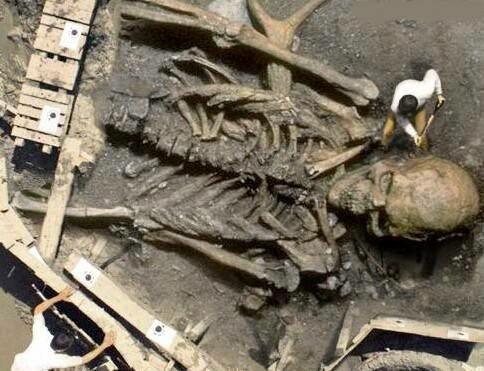American archaeologists diving for Roman artefacts off a packed swimmers' beach in Cyprus found live munitions dating from World War 2 instead, authorities said on Tuesday.
British bomb disposal experts were called in to destroy the device found a few metres away from the shore of a beach neighbouring a British military base on the southern coast of the island.
"The archaeologists were diving for bits of pottery and they saw a metal fin sticking up off the sea bed," British bases spokesperson Dennis Barnes told reporters.
"It could well have been a danger to the public," he said. Experts did not want to risk moving it so it was destroyed in the water.
The precise type of weapon was not immediately clear but experts believed the munition dated from World War 2, Barnes said.
Yeah, they were looking for "bits of pottery" at a Mediterranean beach. Mmm-Hmmm.
And if you want to do it yourself. . . Workshop for training in underwater archaeology
Between 31 May and 25 June, a workshop of underwater archaeology was organised within the framework of La navigation du savoir – Réseau des arsenaux historiques de la Méditerranée, one of the Euromed Heritage II projects.
This project is directed by the University of Malta and Unesco, and financed by the European Commission.
This was the second such course following one held in France in September 2002 in the bay of Villefranche sur mer (Alpes Maritimes), and is aimed at training students from various parts of the Mediterranean in various techniques of underwater archaeology.
See, everyone does underwater archaeology in romantic spots such as all around the Mediterranean and in the Caribbean. Oh sure, they say it's because of the great profusion of shipwrecks, amphorae, etc. that are there. "Oh, we just come to dive off the coast of southern Turkey because there is so much interesting. . . hey, could you pass me the olives? No, no thanks, I've had enough wine for this afternoon. . .so where was I? Oh yes, there's so much interesting archaeology here. Oh sure, I'd love to dive off the rocky shores of Vancouver Island in cold, dark water looking for evidence of the first Americans which would revolutionize our thinking on large-scale migration routes, population growth, and possible human impact on the extinction of Pleistocene megafauna, but you see, that just happens not to be my area of expertise. Say, could you move a bit, you're interfering with my sun. Can't have an uneven tan you know!"
And speaking of the First Americans. . . The Oldest Americans May Prove Even Older
On a hillside by the Savannah River, under tall oaks bearded with Spanish moss, an archaeologist and a graduate student crouched in the humid depths of a trench. They had reason to think they were in the presence of a breathtaking discovery.
Or at the least, they were on to something more than 20,000 years old that would throw American archaeology into further turmoil over its most contentious issue: when did people first reach America, and who were they?
The sandy soil of the trench walls was flecked with pieces of chert, the source of flint coveted by ancient toolmakers. Some of the stone flakes appeared to be unfinished discards. Others had the sharp-edged look of more fully realized blades, chisels and scrapers. Long ago, it seemed, Stone Age hunter-gatherers had frequently stopped here and, perhaps, these toolmakers were among the first Americans.
Read the whole thing. It's a good summary of the mood of archaeologists doing research on the peopling of the New World. We admit something of a bias toward skepticism, even though we see nothing in Monte Verde to categorically deny it as a pre-Clovis site. One would think, however, that people just didn't all of a sudden start making brilliantly-flaked Clovis tools when before they were just chipping haphazardly at bits of rock. It's not like tools are barely recognizable as such at this time in other parts of the world. But, as we have said, if people were here pre-13k there seem not to have been many of them, so perhaps we just need far more samples to get at the undoubted "tools".
Archaeologists discover traces of Colonial history
Dig yields copper clues to relationship between Indians and early settlers
Proof of the relationship between Jamestown's earliest settlers and Virginia's native Indians has turned up in a 400-year-old Indian trash pit.
Archaeologists working at the 10,000-acre U.S. Naval Weapons Station here announced yesterday that an exploration conducted over the past few years has pinpointed the location of a historically important Indian village known as Kiskiak.
But even more important, officials said, is the discovery in a Kiskiak "midden," or trash dump, of two fingernail-size pieces of sheet copper used for trade by Englishmen during the earliest years of Jamestown.
Freedom Park faces conflict
James City County has the tax records and oral history to document Freedom Park in Centerville as the site of a 19th century settlement for free blacks.
But so far, archaeologists have only found artifacts dating to the 17th and 18th centuries, presenting a challenge for county officials as they look to honor the site's role in black history.
"To give some authenticity, we need to find some actual archaeological information," said Alan Robertson, the chairman of the county's Parks and Recreation Advisory Commission. "The part that will draw someone to that site, not just read about it, are some concrete examples."
The Oldest Americans May Prove Even Older
On a hillside by the Savannah River, under tall oaks bearded with Spanish moss, an archaeologist and a graduate student crouched in the humid depths of a trench. They had reason to think they were in the presence of a breathtaking discovery.
Or at the least, they were on to something more than 20,000 years old that would throw American archaeology into further turmoil over its most contentious issue: when did people first reach America, and who were they?
The sandy soil of the trench walls was flecked with pieces of chert, the source of flint coveted by ancient toolmakers. Some of the stone flakes appeared to be unfinished discards. Others had the sharp-edged look of more fully realized blades, chisels and scrapers. Long ago, it seemed, Stone Age hunter-gatherers had frequently stopped here and, perhaps, these toolmakers were among the first Americans.
Actual archaeological method discussed in news Archeologist hunts area for clues to settlement patterns
Archeologist Duane Quates has been in this area for more than a month, doing preliminary research that may change the way archeologists study settlement patterns.
"What I'm looking at mainly is what we call 'settlement hierarchy,'" said Quates, a doctoral student at Michigan State University. "For example, let's take New York City -- it's the biggest city, it's the most complex. Further away you have the suburbs and further away you have the little farmsteads. That's a settlement hierarchy."
In the early 1800s, before this area was settled by white people, Pensacola became a marketplace and port where Creek and Seminole Indians traded deerskins and cattle with the Spanish.
In about 1815, after the Creek Indian War the Indians' land was turned over to the United States, and white people from South Carolina started to settle in this area.
The fact that settlers were coming here from the east, and their goods were being traded to the south, creates an unusual opportunity for archeological research.
"Settlement pattern" archaeology is basically getting a tally of all of the sites in a given area, their sizes, and the different activities performed at them. It's really been a part of archaeology for a long time, but really came into its own in the 1960s and 70s.
More mummy stuff

Mummy's mystery unravels in 3D
Meet 'Nes' - though he may not have been as nice as he looks. In fact, personality type is now pretty much the only thing we don't know about Nesperennub, an Egyptian priest in his forties who lived 2,800 years ago on the banks of the Nile.
In a technological and historical world first, this weekend the British Museum has unveiled or, more accurately, unwrapped the interior of a mummy that had remained sealed since it was made by masters of the ancient Egyptian craft of mummification. The startling operation was carried out without disturbing the intricate wrappings and amulets that were originally placed around his dead body.
Using scanning technology developed by neurological researchers in a London hospital, the British Museum has recreated the kind of public 'unrolling' of a mummy that used to draw crowds in the 19th century. In those days irreversible damage was often caused to the remains inside and many mummies were discarded and lost forever.




